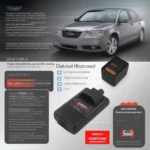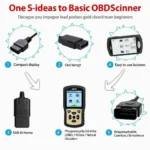Finding the right OBD2 scanner can be a daunting task, especially with the plethora of options available in the market. But fear not, because this guide will help you navigate the world of OBD2 scanners and choose the best one for your needs in 2019.
Whether you’re a car enthusiast, a mechanic, or simply a concerned driver, an OBD2 scanner can be an invaluable tool. It allows you to access and interpret real-time data from your car’s engine control unit (ECU), providing valuable insights into its health and performance.
But before you rush out and buy the first scanner you see, there are several factors to consider. In this comprehensive guide, we’ll delve into the crucial features and functionalities, types, and applications of OBD2 scanners, helping you make an informed decision.
Understanding OBD2 Scanners
The OBD2 (On-Board Diagnostics 2) system is a standardized diagnostic system that has been mandated in all gasoline-powered vehicles sold in the US since 1996. It provides a standardized way to communicate with the ECU, enabling you to access a wide range of data.
Why Should You Use an OBD2 Scanner?
- Diagnose Engine Problems: An OBD2 scanner can help you identify the root cause of engine problems by reading fault codes and providing detailed information about the affected components.
- Monitor Engine Performance: You can track various engine parameters like fuel consumption, air/fuel ratio, and engine load in real-time, enabling you to optimize your driving habits and improve efficiency.
- Reset Check Engine Light: Many OBD2 scanners allow you to clear the check engine light after fixing the underlying issue.
- Save Money on Repairs: Early diagnosis and troubleshooting can help prevent minor problems from escalating into costly repairs.
- Gain Deeper Insights: Understanding your car’s data can help you better understand its operation and make more informed decisions.
Types of OBD2 Scanners
There are different types of OBD2 scanners catering to various needs and budgets. Let’s break down the common types:
Basic OBD2 Scanners:
These are the most affordable and basic scanners that primarily focus on reading and clearing trouble codes. They usually have a small display and limited functionality.
- Pro: Cost-effective, suitable for occasional use, and easy to use.
- Con: Limited features, no live data streaming, and may not be compatible with all vehicles.
Advanced OBD2 Scanners:
These scanners offer a wider range of functionalities, including live data streaming, sensor readings, and graph analysis. They typically have a larger display and more advanced features.
- Pro: Comprehensive data analysis, advanced diagnostics, and compatibility with a wider range of vehicles.
- Con: More expensive than basic scanners.
Wi-Fi/Bluetooth OBD2 Scanners:
These scanners connect to your smartphone or tablet via Wi-Fi or Bluetooth, allowing you to access data and perform diagnostics remotely. They often come with dedicated mobile apps offering additional features.
- Pro: Convenience, portability, and access to advanced features through mobile apps.
- Con: Reliance on a smartphone or tablet, potential connectivity issues, and limited functionality without a mobile device.
Professional-Grade OBD2 Scanners:
These high-end scanners are designed for professional mechanics and technicians. They offer advanced features like bidirectional control, reprogramming modules, and extensive diagnostic capabilities.
- Pro: Advanced diagnostic capabilities, complex troubleshooting, and reprogramming potential.
- Con: Expensive, specialized knowledge required, and often require specialized training.
Key Features to Look for
Here are some crucial features to consider when choosing the best OBD2 scanner for your needs:
Compatibility:
Ensure the scanner is compatible with your vehicle. Most modern cars manufactured after 1996 are equipped with an OBD2 port, but older vehicles may require an adapter.
Connectivity:
Check if the scanner offers the desired connectivity options, such as Bluetooth, Wi-Fi, or a dedicated USB cable.
Display:
The display should be clear, easy to read, and provide relevant information, including trouble codes, live data, and graphs.
Functionality:
Consider your needs and choose a scanner with features like:
- Code Reading and Clearing: Reads and clears trouble codes.
- Live Data Streaming: Displays real-time engine parameters.
- Freeze Frame Data: Captures the conditions leading to a fault code.
- Graphing: Visualizes data trends over time.
- Sensor Readings: Provides access to various sensor readings.
- Emissions Testing: Performs emissions tests for vehicle inspection.
- Bidirectional Control: Allows for controlling actuators and sensors.
Ease of Use:
The scanner should be user-friendly and intuitive, with clear instructions and a simple interface.
Software Updates:
Check if the scanner offers regular software updates to ensure compatibility with the latest vehicle models and diagnostic requirements.
Choosing the Right OBD2 Scanner
Here are some additional tips to help you narrow down your choices:
- Define your Needs: Determine your primary purpose for using the scanner. Are you looking for basic troubleshooting, live data monitoring, or professional diagnostics?
- Consider Your Budget: Set a realistic budget based on your needs and features you require.
- Read Reviews: Check online reviews from other users for insights into the scanner’s performance and reliability.
- Check Compatibility: Ensure the scanner is compatible with your vehicle’s make, model, and year.
- Compare Features: Compare different scanners side-by-side based on their features, functionality, and price.
Pro Tip: If you’re unsure about choosing the right scanner, consult a trusted mechanic or automotive professional for advice.
Frequently Asked Questions
1. Are OBD2 scanners legal to use?
Yes, OBD2 scanners are legal to use in the US.
2. Can I use an OBD2 scanner to modify my car’s performance?
While some OBD2 scanners can access and modify certain engine parameters, it’s important to note that tampering with the ECU can potentially void your warranty and damage your vehicle.
3. How do I connect an OBD2 scanner to my car?
Most vehicles have an OBD2 port located under the dashboard, near the steering wheel. Connect the scanner’s cable to the port and follow the instructions provided by the manufacturer.
4. What are the benefits of using an OBD2 scanner?
OBD2 scanners can help diagnose engine problems, monitor engine performance, clear check engine lights, save money on repairs, and gain deeper insights into your car’s health.
5. Can an OBD2 scanner diagnose all car problems?
OBD2 scanners are primarily designed for diagnosing engine-related problems. They may not be able to identify issues in other systems like the transmission, brakes, or electrical system.
6. How often should I use an OBD2 scanner?
It’s recommended to use an OBD2 scanner at least once a year for basic diagnostics or more frequently if you experience any engine-related problems.
7. What are some popular OBD2 scanner brands?
Some popular OBD2 scanner brands include Actron, BlueDriver, Autel, INNOVA, and Foxwell.
Conclusion
Choosing the best OBD2 scanner is crucial for maintaining your vehicle’s health and saving money on repairs. This guide has provided a comprehensive overview of OBD2 scanners, including their types, features, and key considerations. By following the tips and insights presented, you can confidently select a scanner that meets your needs and unlocks the valuable data hidden within your car’s ECU.
Need help finding the perfect OBD2 scanner for your vehicle? Contact our team of experts at [email protected] or WhatsApp at +1(641)206-8880 for personalized recommendations and support. We’re available 24/7 to answer your questions and guide you through the process.

